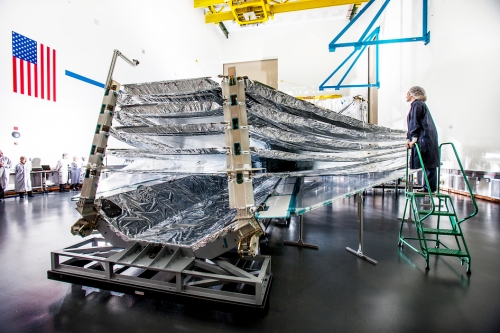
(Photo Credit: Northrop Grumman/Alex Evers)
For the first time, the five sunshield layers of NASA’s James Webb Space Telescope were unfolded and separated; unveiling important insights for the engineers and technicians as to how the deployment will take place when the telescope launches into space.
“These tests are critical and allow us to see how our modeling works and learn about any modifications we may need to make in our design as we move into sunshield flight production,” said Jim Flynn, Webb’s sunshield manager.
The test took seven engineers and six technicians about 20 hours to complete. Once in orbit, the sunshield will take several days to unfold.
The tennis court-sized sunshield, which is the largest part of the observatory, will be folded up around the Webb telescope’s mirrors and instruments during launch.
As the telescope travels to its orbit, one million miles from Earth, it will receive a command to unfold and separate the sunshield’s five layers into their precisely stacked arrangement with its kite-like shape. The sunshield’s membrane layers, each as thin as a human hair, are made of Kapton, a tough, high-performance plastic coated with a reflective metal.
“Tests on the ground are a little bit tricky because we have to account for gravity,” says Flynn. “Webb won’t face those same challenges in space.”
On orbit, the observatory will be pointed so that the sun, Earth and moon are always on one side.
The sunshield separates the observatory into a warm, sun-facing side (where temperatures will reach close to 400 degrees Farenheit), and a cold side (which will dip to 185 degrees below zero). The sunshield will stop sunlight from interfering with the sensitive telescope instruments by providing them with an effective sun protection factor, or SPF, of one million.